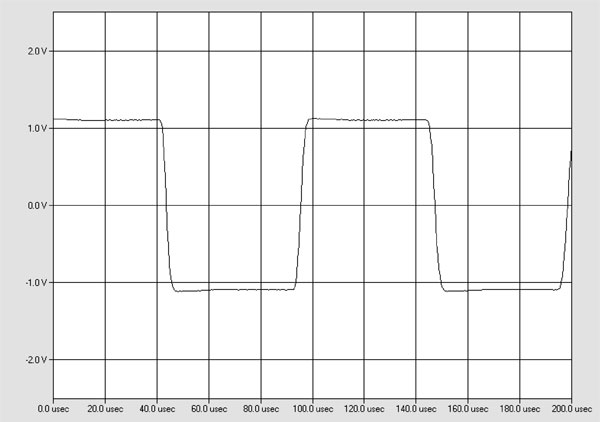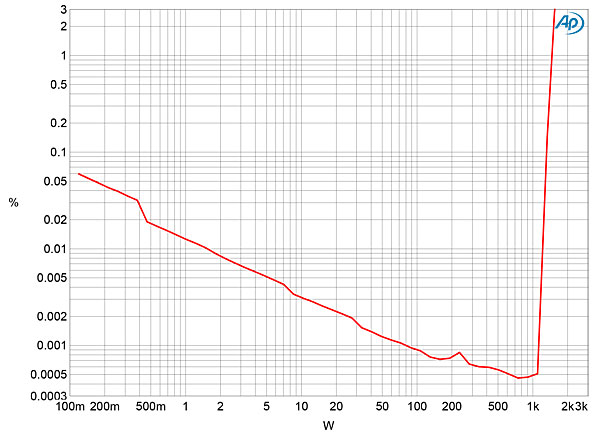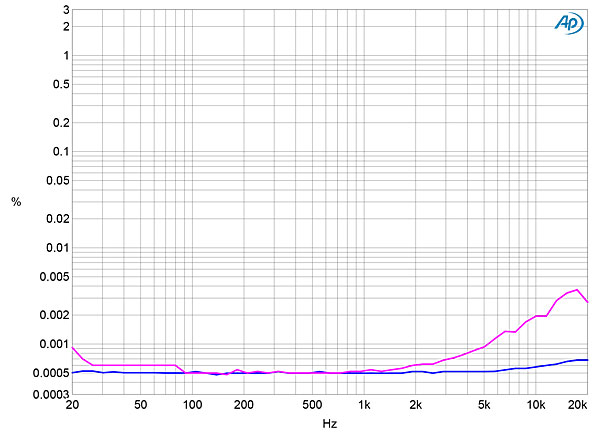| Columns Retired Columns & Blogs |
When do we get to read your comparison of the AudioQuest Hurricane (high-current) and Shunyata Research Zi-Tron Sigma HC?
Because of the Boulder 2150's bulk and weight—319 lbs in its shipping crate—I wouldn't have been able to get it down the stairs to my test lab, much less back up those stairs. So I packed up my Audio Precision SYS2722 system (see the January 2008 "As We See It") and the PC I use to control it, along with analog and digital oscilloscopes, test loads, and all the cables I would need, and drove to Michael Fremer's lair, in deepest, darkest New Jersey.
There, I had a couple of problems. Usually, before doing any testing of a power amplifier, I precondition it by running it at one-third power into 8 ohms for an hour. (With an amplifier having a class-B or -AB output stage, this power level results in the highest thermal stress on the output devices.) However, one-third of the Boulder's specified maximum power of 1000W is 333W, and I don't have a test load that could handle that power level for an hour without overheating. Therefore, I wasn't able to precondition the 2150 before testing it.
My second problem, too, was related to the 2150's power. The only practical place to perform the measurements was in Mikey's garage, which adjoins his house. However, the only electrical outlets within reach of the long extension cords I'd brought with me were on a 15A circuit. (I have two 20A circuits in my test lab.) While this allowed me to test the amplifier's distortion and clipping power into 8 and 4 ohms, the circuit breaker tripped at powers above 800W into 2 ohms, which is well below the specified maximum power of 4000W into this load.
The Boulder 2150's voltage gain into 8 ohms was 25.9dB: a little below the norm, but conforming to the specified 26dB. The amplifier preserved absolute polarity (ie, was non-inverting), with pin 2 of the XLR jack wired as hot. (The review samples were not fitted with unbalanced inputs.) The input impedance at 20Hz and 1kHz was 194k ohms, which is close to the specified 200k ohms, and at 20kHz dropped inconsequentially to 130k ohms. The output impedance, including 6' of speaker cable, was extremely low, at 0.02 ohm at low and middle frequencies; this rose only slightly, to 0.026 ohm, at the top of the audioband. As a result, the variation in frequency response with our standard simulated loudspeaker (fig.1, gray trace) was virtually nonexistent. The frequency response into resistive loads was flat in the audioband, and down by just over 3dB at 200kHz (fig.1, blue, magenta, and red traces). The Boulder's reproduction of a 10kHz squarewave featured short risetimes, and was free from any overshoot or ringing (fig.2).


The 2150 was extremely quiet—its unweighted, wideband signal/noise ratio with the input shorted to ground measured 78.5dB ref. 2.83V into 8 ohms. This improved to 94.3dB when the measurement bandwidth was restricted to the audioband, and to 97dB when A-weighted. Spectral analysis of the Boulder's noise floor while it reproduced a 1kHz tone into 8 ohms (fig.3) indicated that the only power-supply–related spuriae were all very low in level, and primarily comprised the 60Hz AC frequency and its third and fifth harmonics, all of which were close to or below –110dB (0.0003%). This spectrum was not affected when I experimented with the grounding between the Boulder and the test system.

Not only was the Boulder 2150 quiet, it offered very low distortion and very high power. Fig.4 plots the percentage of THD+noise against output power into 8 ohms. The downward slope of the trace below 200W or so indicates that whatever distortion is present lies below the noise. The 2150 clips sharply, reaching 1% THD+N at 960W (29.8dBW). This is 0.2dB lower than the specified 1000W (30dBW), but this is most likely due to the fact that I didn't hold the wall voltage constant during this test. Fig.5 is a similar graph for 4 ohms: The 2150 clips at 1450W into this load (28.6dBW), but again, note that I didn't hold the wall voltage constant.


Not only was the Boulder's distortion very low; into 8 ohms, it hardly changed with frequency, even at 40V (fig.6, blue trace). There was a rise at higher frequencies at this same level into 4 ohms (fig.6, magenta), but to no higher than 0.004%. And at 1kHz at 40V into 4 ohms, the distortion waveform was mainly noise, with the faintest hint of third harmonic (fig.7). Spectral analysis (fig.8) indicates that the third harmonic at this level lies at –119dB (0.0001%), which is about the same level as the third harmonic of the AC supply frequency. Intermodulation distortion is also extraordinarily low (fig.9).




Boulder's 2150 is an extraordinary amplifier. It measured so well that it taxed the capabilities of my Audio Precision SYS2722 (footnote 1).—John Atkinson

When do we get to read your comparison of the AudioQuest Hurricane (high-current) and Shunyata Research Zi-Tron Sigma HC?

'"I'm a recording engineer, so I value accuracy," said a panelist in a discussion—titled "How to Read Between the Lines of Audio Advertising"'
Was your response to this statement deliberate trolling or are you really that unfamiliar w/ what recording engineers do? He meant, and I can't believe I have to explain this to you, that what comes out of the amp should be the same as what went in, but amplified. Jeez.
It's like your silly trolling of people (some of whom are also trolling) who say they prefer digital to analog. The correct answer is neither is better than the other, they each do different things well and really it's a matter of which distortions one prefers.
Note, I worked as a recording engineer in the early 90's - classical, jazz, rock, and pop; I did it all.

I've wasted a lot of money in this silly hobby thinking if I moved up to the next level, I'd get better results. Experience and approx. $80k (over the years) I know better... Of course, maybe if I had of pushed up even further to Boulder/etc., I would've finally gotten "there"...

Not sure what this has to do with what I wrote... but if you can't hear the difference between, say, a well designed Class A amp and a well designed class AB or D amp then the problem may simply be that your hearing (or ability to discern fine grain differences in sound) is not up to snuff. Most wine, to me, tastes like grape juice mixed with vodka but I don't doubt that's not the case with most people who actually like wine (I obviously don't), and an experienced wine taster can glean a lot of information from shades of flavor most of us cant discern.
I spent about 5 years where my job was, essentially, to listen carefully (recording engineer). I could hear the distinct differences between two Steinway 9' grands we had my at first job at UT Austin (the Hamburg had more scintillating high harmonics, the NY had fuller low mids) and a Baldwin 9' grand we had (less high end "air" than either Steinway, more pronounced mids than either - no wonder 70's rock bands liked 'em - better at cutting through a mix). I could tell musicians the exact point where they stopped just playing and started thinking about playing (nothing kills feel like thinking about it). Clear differences between different compressors, different EQ's, different reverbs, etc. Audiophiles like to rag on rock/pop recording engineers, but the truth is we pay almost fetishistic attention to the sound but it's the artist and label (the boss) who determine what the final product sounds like (i.e. hard limited, clipped no dynamic range EQ'd to hell and back ear torture of the "loudness wars").
That's something that I like about Stereophile - many of their reviewers have either played or recorded music professionally (or both) so I know they've done a LOT of listening. Also, unlike, say, TAS, they publish measurements of the gear they listen to.

Not worth a response.


“Can you measure "dry"? Probably not—but you can hear it.”
Of course you can measure dryness. It’s the lack of harmonic distortion or reverberation in space to which our ears are continually exposed and become accustomed to. You feel something is missing, and you call that dryness. You can say the same of a music hall which absorb an unusually high level of reflections. We call that “dry” because we don’t hear the multiple layers of sound that we hear otherwise.
Anyway, I just wanted to correct this unfounded belief that you can’t measure everything you can hear. Sean Olive even demonstrated that you can measure “good sound”, despite the very subjective nature of this concept. There is consistency in nature. A very few things are arbitrary, even if you’ll find some aberrant data and some people who have developed a dislike for accuracy (and will advance the hypothesis that it doesn’t even exist).

Mr. A. Hourst, you should be employed by Stereophile as a reviewer.
Reviewers use words like cold, warm, dry, laid-back, etc, etc. No one ever explains what those words mean or in terms describing sound.
I always believe if you can hear sound, you can measure it.

Do you really think everything that can be measured has been discovered? I don't.

What does: warm, cold, dry, analytical, laid back, forward, aggressive all mean.
Are these terms objective or subjective? If a reviewer says and amplifier sounds cold, does that mean the samething as someone saying they feel cold when the temperature drops?

What does: warm, cold, dry, analytical, laid back, forward, aggressive all mean.
Check out J. Gordon Holt's subjective audio glossary at https://www.stereophile.com/reference/50/index.html.
John Atkinson
Editor, Stereophile

I would guess this reader does not drink wine or coffee both of which are described with equally useful descriptors.

He participated in a fraudulent radio show about vinyl vs. CDs.

I still don't believe we can measure everything that can be heard. And I don't buy your definition. Of course you can measure "good sound" versus bad sound but that doesn't mean everything can now be measured, or even that what can be measured is done with complete accuracy. I still believe the human system is superior to what's been devised by man.

I buy and read Stereophile because they publish measurements; I would not buy/read it otherwise. I read the measurements section almost exclusively, since I think that everything else in Stereophile (and especially subjective reviews) has very little value.
But the measurements are worth the price of subscription!

"everything else in Stereophile (and especially subjective reviews) has very little value"
I can't agree more. For example, Mr Fremer, in this review, avoid saying that there exist some "good enough" amplifiers that will sound exactly the same for a fraction of the price. Once you're below a certain threshold of distortion and output impedance, and have enough power, the differences become imperceptible.
Boulder still has a lot of merit for engineering such a stellar measuring amplifier.

I avoided saying what you write because I don't believe it.

Because it's simply not true.

"Once you're below a certain threshold of distortion and output impedance, and have enough power, the differences become imperceptible"
Imperceptible ? to whom? Sir, I have been listening critically to amplifiers driving loudspeakers since 1966. Many of my best friends (even back then) were (and still are) brilliant amp designers. Not one of them, nor I, would make that statement. Have you personally experienced this phenomenon ? Also....Neither they nor I believe a quality amplifer is easy or inexpensive to make.
I am certain MF is one of the most experienced audio listener/observers on the planet, and I personally, place great trust in his observations. (Perhaps we should compare an vintage Hafler DH-500 to this obviously well-engineered Boulder? Do you think you could hear the difference?)

Mr Reichert,
Distortion and frequency response variations (which are typically very low in any well-conceived amplifier), are the only factors that can alter the sound of an amplifier. There’s no dispersion pattern like in loudspeakers, so it’s pretty much a straightforward 2-D signal very simple to measure. All your typical audiophile discourse about “bright” or “dark”, “rich” or “dry”, “musical” or “analytical” is embedded in those two parameters. Each one of them represents either an alteration of the frequency response or the signal integrity. I mean, how else could it be? People who have problems with this assertion invariably fail to 1) measure, 2) match the level within 0.1 dB or 3) listen blind. Usually, they even reach their conclusions based on memory. The problem is you can’t free your mind from its numerous prejudices (a 100 000$ amplifier will surely sound better than a 1000$ one) and aural memory is very fragile, since we tend to listen to something different every time music is played.
I do not question your or your friend’s experience or human qualities. I question the methodology, or lack of, that usually goes into the evaluation of most electronic devices.
And since you make this very personal, no I don’t place Mr Framer as an audio authority.

You're completely ignoring that the amplifier and speaker(s) are a system that interact quite a lot... and a lot of other things. I'm sorry you don't have the ability to hear a lot of these things, maybe spend more time listening - it's a fact that the more time you spend doing something, the more neurons your brain will devote to it. Just as an experienced wine taster can discern shadings of flavor you can't, so can an experienced listener.
There is a lot of sillyness in high end audio (like claiming a power cord coming directly from a wall outlet having an effect on the sound ignores 100 feet of Romex upstream in the wall - assuming both cords are of the same gauge of pure copper wire there won't be a difference) but this isn't one of those things.
Fun story - I once was auditioning a Tandberg preamp (used) to replace my old NAD preamp circa 1990. The sound was significantly different (it sounded like George Massenberg gear - he invented parametric EQ btw) and excellent but I ended up not buying because the RCA jack was poorly designed and the sleeve came off when removing an interconnect. That was just a preamp... if only the build quality had been better I'd have bought it - Tandberg gear was top notch.

Did you match the level to 0.1 dB?
That's a major "difference maker".
Those interactions you're talking about are the result of high output impedance.
My experience is that the sound of electronics is extremely overrated.

good to know that you're just talking out your ass. If you want to know what George Massenburg's equipment sounds like, compare 2 Flim & the BB's albums, anything from DMP (Tom Jung engineered) vs "New Pants" on Warner Bros. If you cannot hear the difference (no level matching required), you are not qualified to comment on audio, at all.

Amp Voltage output capabilty as a function of signal phase change and through changing impedance is measured by other Audio mags. The power cube as the Germans call it, Yes there are "Music" signal loads that test the ability of the amp dealing with the speaker. So your story is a bit shortsighted. It just is not that simple and the amp should be tested with several speakers with different drivers and filters.

Can't even correctly spell my name. I have participated in blind amplifier tests and disproved all of your ridiculous assertions.
However, because my results at an AES of all places (based upon decades of experience) fell outside of the 'average', it was TOSSED.
So guess what? i no longer participate in these wank fests.
But if you believe what you've written, enjoy! Knock yourself out. Say negative things about me too. I could give a shit!

And your comment is idiotic. Every amplifier I've reviewed sounded different. You live within the narrow walls of your foolish comfort zone. Good for you. Mr. Hourst.

Why are you here?

Interesting mention of Boulder's avoiding resonating fins, a legitimate concern if a fine point. That is why one of my amps with large fins has dampers inserted between every fin. Running a hand across the fins before that produced obvious ringing, yes. Even after the dampers they try to a little but I did not want to compromise the cooling too much so I stopped where I did.
Did I hear much difference after the dampers? Not a lot but enough to say that there was an improvement and the cost-free tweak was worth spending a few minutes on and something anyone can take care of themselves. The amp is not overtaxed so it does not run super hot, still, after many years the foam dampers are still in fine shape. It should be noted that that amp was being used on only the woofers in a triamped system so additional harmonics would have been cut off by that factor or I may have heard even more of a change. But that this matters became provably true and Boulder's attention to that detail is appropriate to a product costing that much and admirable.